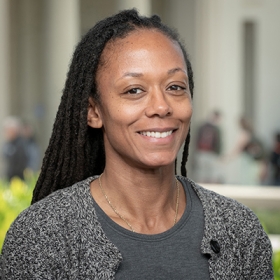
Janna Ireland's concentration is in the medium of photography.
In 2016, she began photographing structures designed by legendary Black architect Paul R. Williams. A collection of 250 of these photographs was published in a monograph entitled Regarding Paul R. Williams: A Photographer's View, in 2020. In 2021, Ireland was awarded a Peter E. Pool Research Fellowship by the Nevada Museum of Art to photograph Williams' work in Nevada. The resulting exhibition traveled from the Nevada Museum of Art to the Nevada State Museum and the AIA Center for Architecture in New York. Ireland is the recipient of the 2023 Carolyn Glasoe Bailey Foundation Art Prize. Her mid-career survey, Janna Ireland: True Story Index, will be on view at the Santa Barbara Museum of Art and the Museum of Contemporary Art Santa Barbara through June 2, 2024.
A broad selection of Ireland’s work was included in the exhibition “Family Album: Dannielle Bowman, Janna Ireland and Contemporary Works from LACMA” at the Los Angeles County Museum of Art’s Charles White Elementary School Gallery. Ireland’s photographs are held in the permanent collections of institutions including LACMA, SFMOMA, the Nevada Museum of Art, the California African American Museum, the Santa Barbara Museum of Art, and the Museum of Contemporary Photography at Columbia College Chicago. Her work has been the subject of articles in publications including The New York Times, the Los Angeles Times, the Financial Times, Harvard Design Magazine, and Aperture.
Courses
ARTS 281 Photography: Self As Subject
A studio course about the use of the self in photography. Students will produce new photo-based projects which may include self portraits (What counts as a portrait? What constitutes the self?) as well as loose or alternative interpretations of the theme, such as work that explores the self through family history. The special focus on the notion of "self" offers a way to engage not only with individual "self-representation," but also with the ways a "self" might emerge from, and shape, other modes of identity: family, community, nation, transcultural. Thus, the course is not only a fine arts course, but also a course that expressly engages with issues of Diversity, Equity, and Inclusion as explored through the experiences, histories, and contemporary lives of students, faculty and the larger communities that an individual may imagine themselves to be a part of. Discussion topics will include gesture and expression, the gaze, beauty, identity, narcissism (actual and perceived), memory and time, and self portrait methodology. Lectures will offer an overview of the history of self-portraiture in photography, from the medium?s early days though contemporary social media.
ARTS 282 Photography: LA Stories
This studio course will focus on the study of place in photography, with a particular focus on Los Angeles County. As both a global center of the film industry and the city of choice for many artists, LA occupies a unique position in visual culture and the collective imagination. Students will spend the semester working on a photographic project that explores a particular aspect of life in LA?such as a unique community, culture, or subculture, history, climate, geography, or architecture?in depth. Discussion and lecture topics will include photographing communities as both an outsider and an insider, what defines a place, the nuances of photographic genre (journalism, fine art, etc.), and the rich cultural topography of Los Angeles. We will also explore events and policies that have shaped our experience of the region, such as the construction of the freeways, redlining, and restrictive covenants. Special emphasis will be placed on guest lectures from photographers who explore place in their own work and writers who engage with the history of Los Angeles. Students must enter this course with a foundation in digital photography. They should either have taken ARTS 107 (Digital Photography), or should be able to provide instructor with a narrative about their experience in photography.
ARTS 283 The Photograph as Object
A course that celebrates the physical production of photographs. For the first century and a half of photographic history, a photograph was typically an object to be held in one's hand or hung on a wall. Today, it is not uncommon for a photograph to exist only in digital form; the entire life cycle of an image may take place on a series of screens. In this course, students will focus on producing tangible photographic objects. Each student will conceive of a photographic project in which a final, physical form (such as an artist book or photo-based sculpture) is central to the concept. The first part of the semester will be devoted to lectures, research, technical demonstrations, and exercises to help students decide on a direction and form for their final projects. Next, students will work intensively to produce a new series of photographs (digitally or on film) that will be refined through group critiques; editing and sequencing will be important topics of discussion at this stage. Finally, students will focus on producing their object(s), taking concepts and skills from the first part of the semester and applying them to their new images. Students will have the opportunity to print in the black and white darkroom and/or with a large-format digital printer. Prerequisite: ARTS 107.
ARTS 307 Advanced Projects in Photography
Advanced study in photography, including developing a theoretical, historical and critical understanding of materials and media. In this studio course, students will produce complex photographic projects in a genre and photographic medium of their choosing. Students will be expected to refine technical and conceptual skills developed in lower-division photography courses and produce projects that express concepts in a sustained manner. Much emphasis will be placed on critiques, where students will be expected to analyze peer work and provide substantive feedback. Lecture and discussion topics will include editing and sequencing, studio lighting, fine art print production, and exhibition techniques.
